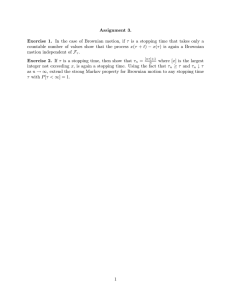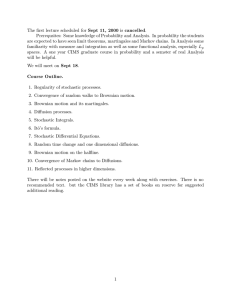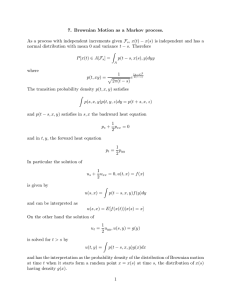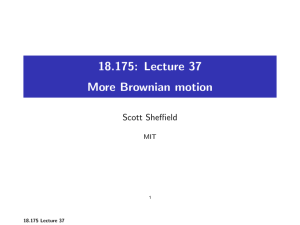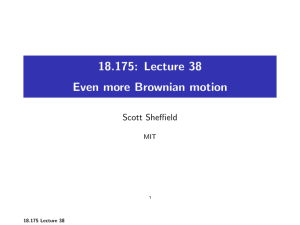Document 13424501
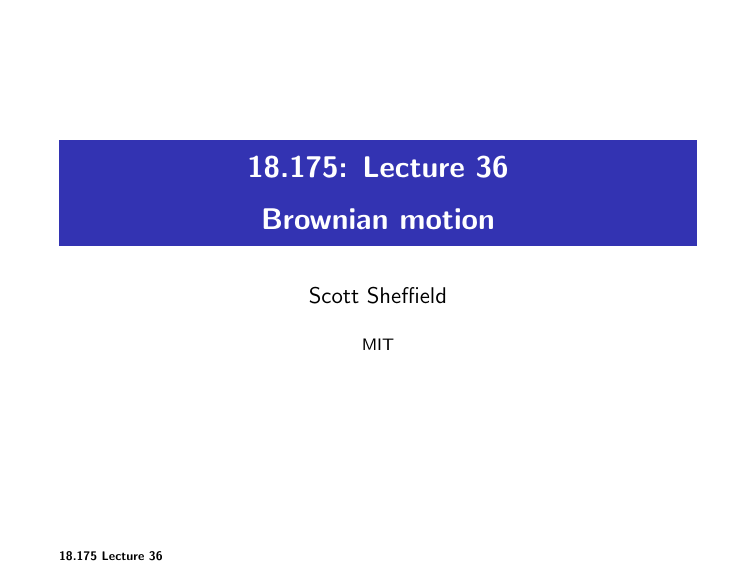
18.175
Lecture 36
18.175: Lecture 36
Brownian motion
Scott Sheffield
MIT
Outline
Brownian motion properties and construction
Markov property, Blumenthal’s 0-1 law
18.175
Lecture 36
Outline
Brownian motion properties and construction
Markov property, Blumenthal’s 0-1 law
18.175
Lecture 36
Basic properties
� Brownian motion is real-valued process B t
, t ≥ 0.
� Independent increments: If t
0
< t
1
< t
2
. . .
then
B ( t
0
) , B ( t
1
− t
0
) , B ( t
2
− t
1
) , . . .
are independent.
� Gaussian increments: If s , t ≥ 0 then B ( s + t ) − B ( s ) is normal with variance t .
� Continuity: With probability one, t → B t is continuous.
� Hmm...
does this mean we need to use a σ -algebra in which the event “ B t is continuous” is a measurable?
� Suppose Ω is set of all functions of t , and we use smallest
σ -field that makes each B t does that fail?
a measurable random variable...
18.175
Lecture 36
Basic properties
Translation invariance: is B t
0
+ t
− B t
0 a Brownian motion?
Brownian scaling: fix c , then B ct agrees in law with c
1 / 2
B t
.
Another characterization: B is jointly Gaussian, EB s
EB s
B t
= s ∧ t , and t → B t a.s.
continuous.
= 0,
18.175
Lecture 36
Defining Brownian motion
Can define joint law of B t values for any finite collection of values.
Can observe consistency and extend to countable set by
Kolmogorov.
This gives us measure in σ -field F
0 cylinder sets.
generated by
But not enough to get a.s.
continuity.
Can define Brownian motion jointly on diadic rationals pretty easily.
And claim that this a.s.
extends to continuous path in unique way.
Check out Kolmogorov continuity theorem.
Can prove H¨ continuity using similar estimates (see problem set).
Can extend to higher dimensions: make each coordinate independent Brownian motion.
18.175
Lecture 36
Outline
Brownian motion properties and construction
Markov property, Blumenthal’s 0-1 law
18.175
Lecture 36
Outline
Brownian motion properties and construction
Markov property, Blumenthal’s 0-1 law
18.175
Lecture 36
More σ -algebra thoughts
Write F o s
= σ ( B r
: r ≤ s ).
Write F + s
= ∩ t > s
F o t
Note right continuity: ∩ t > s
F
+ t
= F + s
.
F + s allows an “infinitesimal peek at future”
18.175
Lecture 36
Markov property
If s ≥ 0 and Y is bounded and C -measurable, then for all x ∈
R d , we have
E x
( Y ◦ θ s
|F + s
) = E
B s
Y , where the RHS is function φ ( x ) = E x
Y evaluated at x = B s
.
18.175
Lecture 36
Blumenthal’s 0-1 law
If A ∈ F
+
0
, then P ( A ) ∈ { 0 , 1 } (if P is probability law for
Brownian motion started at fixed value x at time 0).
There’s nothing you can learn from infinitesimal neighborhood of future.
18.175
Lecture 36
MIT OpenCourseWare http://ocw.mit.edu
18.175 Theory of Probability
Spring 2014
For information about citing these materials or our Terms of Use, visit: http://ocw.mit.edu/terms .





